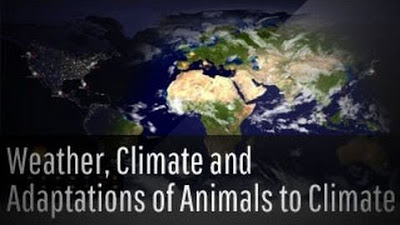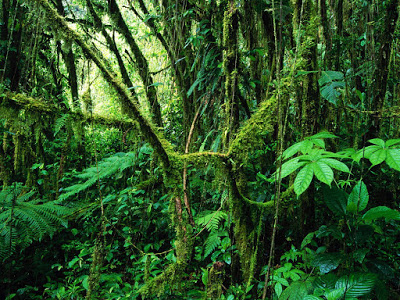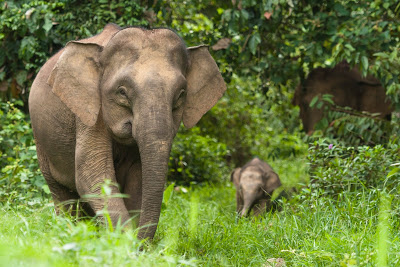
1) Name the elements that
determine the weather of a place.
determine the weather of a place.
ANSWER:-
The temperature, humidity, rainfall, wind- speed, etc. are called the elements
that determine the weather of
a place.
The temperature, humidity, rainfall, wind- speed, etc. are called the elements
that determine the weather of
a place.
2) When are the maximum and
minimum temperature likely to occur during the day?
minimum temperature likely to occur during the day?
ANSWER:-The
maximum temperature of the day occurs in the afternoon while the minimum temperature occurs early
in the morning.
maximum temperature of the day occurs in the afternoon while the minimum temperature occurs early
in the morning.
3) Fill in the blanks:
(i) The average weather taken
over a long time is called climate.
over a long time is called climate.
(ii) A place receives very little
rainfall and the temperature is high throughout the year, the climate of that place will be hot
and dry.
rainfall and the temperature is high throughout the year, the climate of that place will be hot
and dry.
(iii) The two regions of the
earth with extreme climatic conditions are the polar region and the
tropical region.
earth with extreme climatic conditions are the polar region and the
tropical region.
4) Indicate the type of
climate of the following areas:
climate of the following areas:
ANSWER:-
(a) Jammu and Kashmir:
Moderately hot and wet
Moderately hot and wet
(b) Kerala: Hot and wet
(c) Rajasthan: Hot and
dry
dry
(d) North-east India: Wet
5) Which of the two
changes frequently, weather or climate?
changes frequently, weather or climate?
ANSWER:-Weather
changes frequently.
changes frequently.
6) Following are some of the characteristics
of animals:
of animals:
(i) Diets heavy on fruits (ii)
White fur (iii) Need to migrate (iv) Loud voice(v) Sticky pads on feet (vi)
Layer of fat under skin (vii) Wide and large paws
(viii) Bright colours (ix) Strong tails (x) Long and large beak .For each
characteristic indicate whether it is adaptation for tropical rainforests or Polar
Regions. Do you think that some of these characteristics can be adapted
for both regions?
White fur (iii) Need to migrate (iv) Loud voice(v) Sticky pads on feet (vi)
Layer of fat under skin (vii) Wide and large paws
(viii) Bright colours (ix) Strong tails (x) Long and large beak .For each
characteristic indicate whether it is adaptation for tropical rainforests or Polar
Regions. Do you think that some of these characteristics can be adapted
for both regions?
ANSWER:-
(i) Diets heavy on fruits →Tropical rainforests
(ii) White fur → Polar Regions
(iii) Need to migrate → Polar Regions
(iv) Loud voice → Tropical rainforests
(v) Sticky pads on feet → Tropical rainforests
(vi) Layer of fat under skin →Polar regions
(vii) Wide and large paws → Polar Regions
(viii) Bright colours → Tropical rainforests
(ix) Strong tails → Tropical rainforests
(x) Long and large beak →Tropical rainforests
No, none of the above
characteristics can be adapted for both regions.
characteristics can be adapted for both regions.
7) The tropical rainforests has
a large population of animals. Explain why it is so.
a large population of animals. Explain why it is so.

ANSWER:-The
climate of tropical rainforests is generally hot and humid with continuous
rain.
climate of tropical rainforests is generally hot and humid with continuous
rain.
These hospitable climatic
conditions support huge populations of plants and animals
conditions support huge populations of plants and animals
8) Explain, with examples, why
we find animals of certain kind living in particular climatic conditions.
we find animals of certain kind living in particular climatic conditions.
ANSWER: – Animals are adapted to
survive in the conditions in which they live. Features and habits which help them to adapt
to their surroundings are the result of evolution. So, to survive in a particular type of
climate the animals must have certain adapted features
survive in the conditions in which they live. Features and habits which help them to adapt
to their surroundings are the result of evolution. So, to survive in a particular type of
climate the animals must have certain adapted features
9) How do elephants living in
the tropical rainforests adapt themselves?
the tropical rainforests adapt themselves?
 ANSWER:-An important and widely found animal of Indian
ANSWER:-An important and widely found animal of Indiantropical rainforests is the elephant. It has adapted remarkably to the
conditions of this region. Some of the adaptations are as follows.
(i) It uses its trunk as nose so
that it has a strong sense of smell.
that it has a strong sense of smell.
(ii) Its trunk is also used for
picking up food.
picking up food.
(iii) Its tusks are used to tear
bark of trees. It can eat barks of trees.
bark of trees. It can eat barks of trees.
(iv) The soles of their feet are
covered with thick pads. These pads can handle their enormous weight. They also prevent sound
so that the elephants can move silently.
covered with thick pads. These pads can handle their enormous weight. They also prevent sound
so that the elephants can move silently.
(v) Its large ears have strong
sense of hearing.
sense of hearing.
10) Choose the correct option
which answers the following question: A carnivore with stripes on its
body moves very fast while catching its prey. It is likely to be found
in
which answers the following question: A carnivore with stripes on its
body moves very fast while catching its prey. It is likely to be found
in
(i) Polar regions
(ii) Deserts
(iii) Oceans
(iv) Tropical rainforests
ANSWER :-(iv)
tropical rainforests
tropical rainforests
11) Which features adapt polar
bears to live in extremely cold climate?
bears to live in extremely cold climate?
(i) A white fur, fat below
skin, keen sense of smell.
skin, keen sense of smell.
(ii) Thin skin, large eyes, a
white fur.
white fur.
(iii) A long tail, strong
claws, white large paws.
claws, white large paws.
(iv) White body, paws for
swimming, gills for respiration.
swimming, gills for respiration.
ANSWER:-A
white fur, fat below skin, keen sense of smell
white fur, fat below skin, keen sense of smell
12)Which option best describes
a tropical
region?
a tropical
region?
(i) hot and humid
(ii) moderate temperature,
heavy rainfall
heavy rainfall
(iii) cold and humid
(iv) hot and dry
ANSWER:-Hot
and humid
and humid